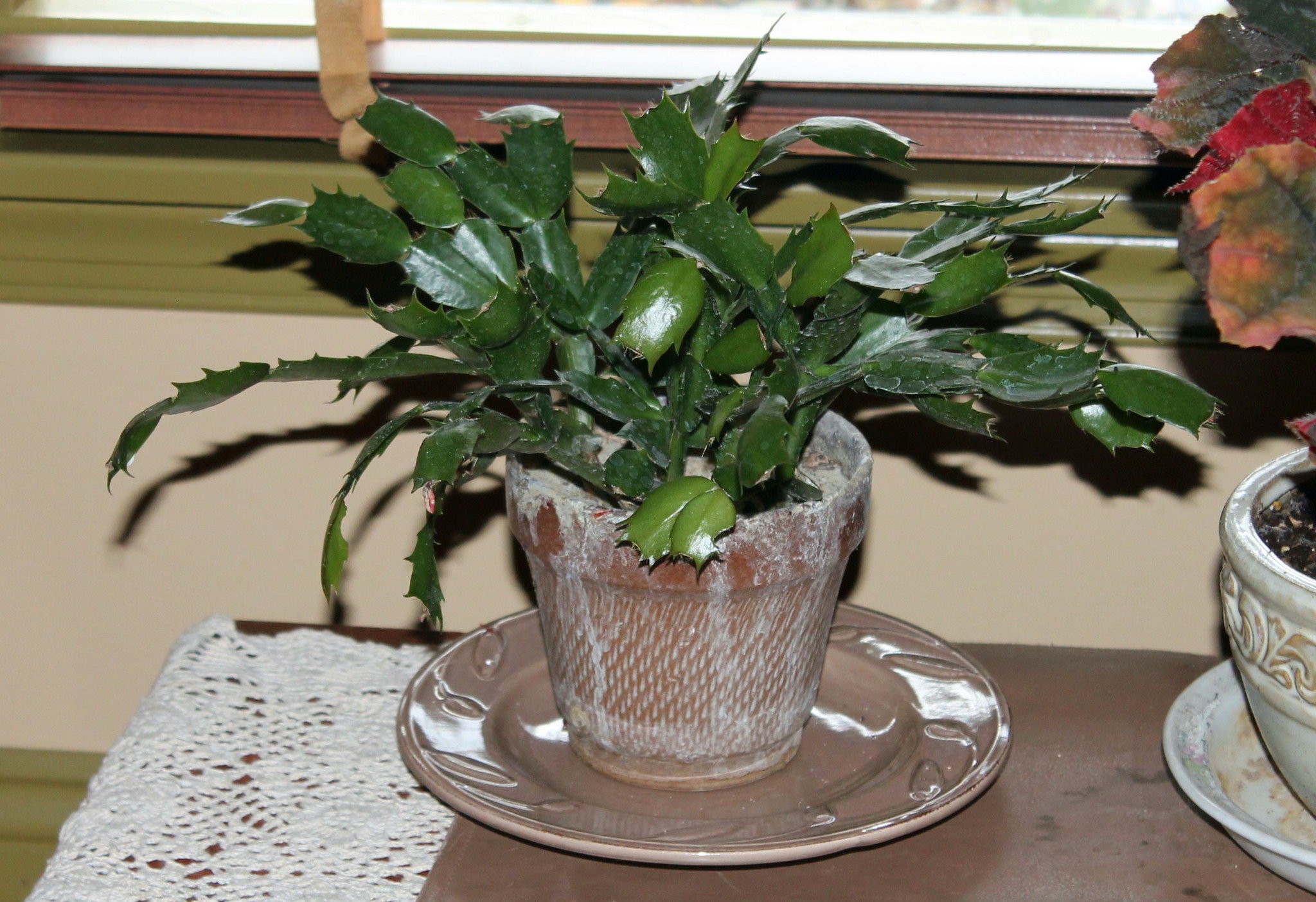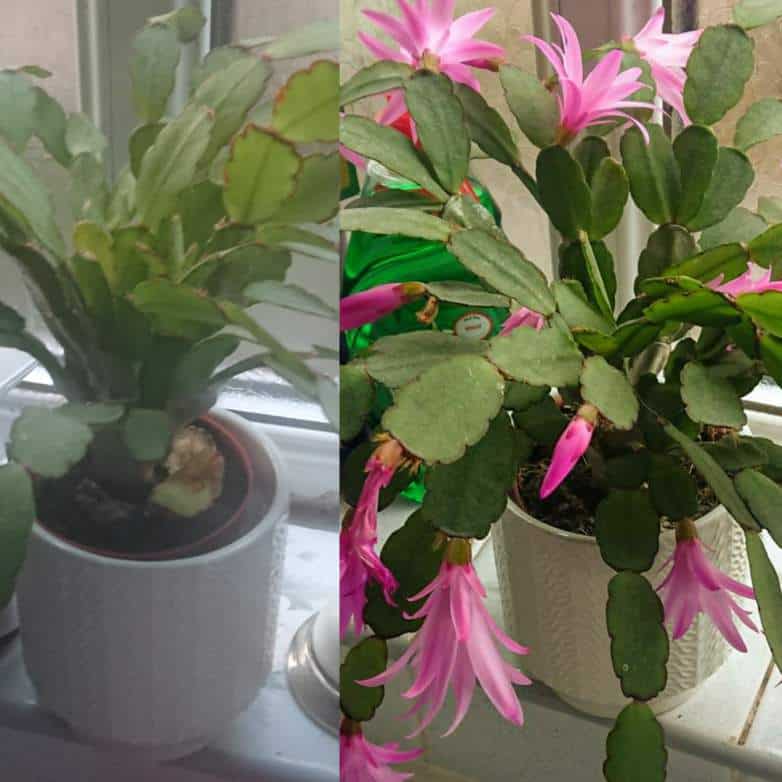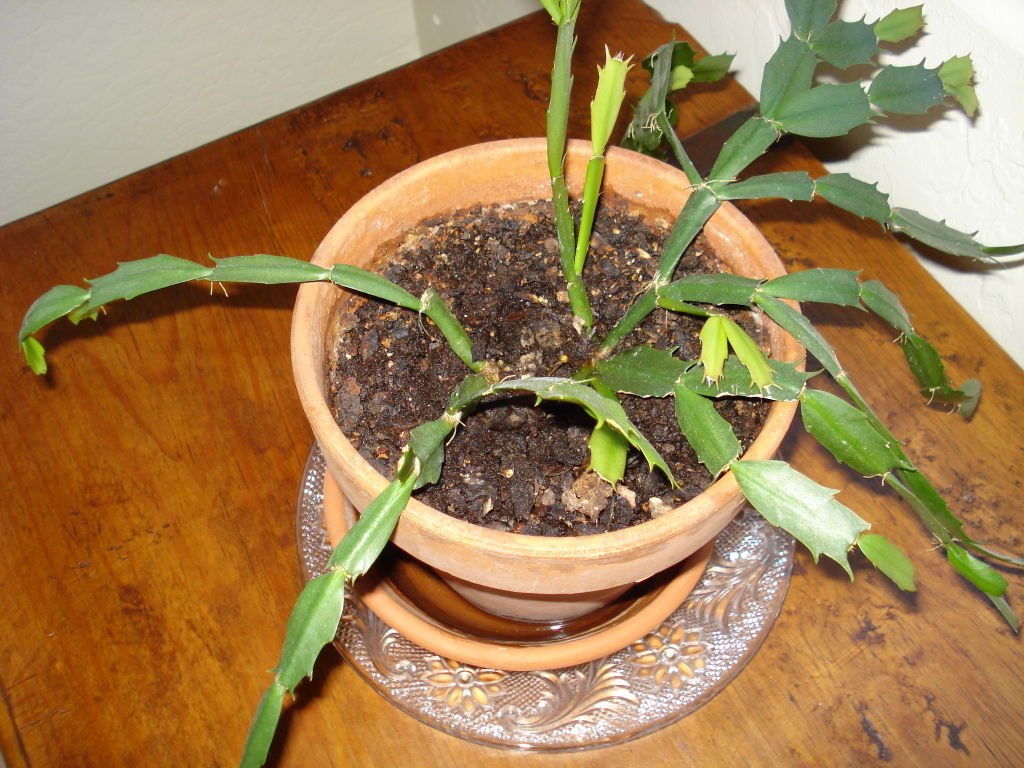
Due to its short day length, the Christmas cactus cannot blossom due to drought stress or excessive light exposure. Christmas cacti are adapted to wet, frequently rainy jungles. If the conditions are dry or there are too many hours of sunshine during bloom production, it does not flower.
I’ve listed here a few other reasons that can stop the Christmas cactus (Schlumbergera) from flowering:
| Conditions: | Several causes include the following: |
| Low humidity and underwatering. | The Christmas cactus demands greater moisture and humidity than the other cacti to encourage flowering. It is a native of the rainforest. |
| Too much light is available. | As a short-day plant, the Christmas cactus needs at least 12 hours of darkness every day for six weeks starting in about September in order to develop flower buds. |
| substantial pots or containers. | Greater pot sizes promote root growth as opposed to floral display. To encourage flowering, Christmas cactus prefers for its root system to be slightly pot-bound. |
| incorrect temperature | Although 60°F (15°C) is favored for the growth of flower buds during the hours of darkness, 68°F (20°C) is the ideal growing temperature. |
| There is too much moisture near the roots. | The root rot and moisture stress brought on by saturated soil impede blossoming. |
| too much sunlight | Indirect right light is preferred for Christmas cactus. The plant may become burned in direct sunlight. |
| A surplus of fertilizer. | Feeding the cactus during the flowering stage prevents flowering. |
Continue reading to learn why your Christmas cactus isn’t blossoming and the finest methods for putting remedies in place so that it can produce blossoms.
Table of Contents
1. Under Watering and Low Humidity
The Christmas cactus is a plant that is indigenous to Brazil’s tropical rainforests, where it thrives in hot, humid weather with somewhat high rainfall while being sheltered by the tree canopy.
Contrast this with the majority of cacti species, which thrive in dry, hot climates with little humidity and infrequent rainfall and have evolved in various ways to withstand drought.
The word “cactus” conjures up images of desert-dwelling creatures, leading people to believe that Christmas cactus requires little irrigation, despite the fact that the opposite is actually true.
Christmas cactus is unable to flower due to drought stress. Christmas cactus suffers from drought stress if it is submerged, the soil dries up too rapidly, or the humidity is too low.
This is a mistake I made personally, and it took me re-creating some of the circumstances of the cactus’ native environment with higher humidity and more frequent watering for my cactus to flower properly.
To promote the blooming of a Christmas cactus…
- More frequently, water your Christmas cactus. Regular weekly watering gives your cactus the ideal amount of moisture to meet its needs for water without leading to root rot, allowing it to blossom without being overly stressed by moisture.
- Regularly mist the cactus, especially if you reside in a dry climate. Regular misting is necessary to establish a humid microclimate to slow water loss from the leaves and recreate the perfect circumstances for plants because homes often have lower humidity levels than the outdoors and considerably lower levels than rainforests. For optimal effects, spray the leaves at least once per week in temperate areas and twice or three times per week in dry climates.
- Give the cactus a good bath in water. If you water your plants too little, the moisture won’t reach the roots and will instead produce drought stress, which inhibits flowers from blooming.
If the cactus is put in potting soil that contains peat, which repels water off the surface when it dries up, that could present another potential issue with underwatering.
This may hinder water from penetrating the soil effectively, which would prevent the roots from absorbing the necessary moisture.
If the potting soil repels moisture, either transplant the cactus in more porous soil that has been improved with horticultural sand or grit, or immerse the soil in a basin of water for 10 minutes to ensure that water can adequately absorb to reach the roots.
The Christmas cactus has a better chance of flowering in your house with routine watering and higher levels of localized humidity caused by misting the leaves to mimic the natural environment.
(Read my post to find out how much and how frequently, according on your environment and conditions, should water your Christmas cactus.)
2. Christmas Cactus Requires at least 12 Hours of Darkness to Flower
Because the Christmas cactus is a “short day plant,” which means it needs at least 12 hours or more of uninterrupted darkness to develop bloom buds, it is fairly unique.
The cacti’s ability to grow flower buds and bloom can be hampered if the 12 hours or more of darkness are broken by putting on lights in the middle of the night.
This is because the Christmas cactus has evolved to sense seasonal change by recognizing changes in daylight hours to begin the development of flower buds.
Christmas Cactus relies on both day length and temperature change in its natural habitat of the rainforest to stimulate the production of flower buds and signal the appropriate time for blossoming. Most plants sense a seasonal shift in temperature, which subsequently encourages the formation of flower buds.
Make sure your cactus is in an area that stays dark at night to encourage blooms around Christmas because even turning on a strong light for a short period of time might hinder the development of flowering.
One option is to cover your Christmas cactus with a light-emitting cloth to provide it with a sufficient amount of darkness to encourage flowering.
(Read my article for more information, why are the buds on my Christmas cactus dropping if your flower buds are growing and then disappearing?)
3. Prefers Being Pot Bound for Flowering
Christmas cacti actually prefer smaller containers because their roots are somewhat constrained and pot-bound.
Without any sort of stress, Christmas cacti do not necessarily flower.
The Christmas cactus’ energy will likely be diverted away from flowering and instead go toward spreading out its root system if it is put in a large pot.
As flowering is the plant’s method of reproduction as a strategy to survive even in difficult circumstances, when the cactus is pot-bound, it prioritizes creating flower buds over the growth and development of the plant.
The plant has less motivation to develop blossoms if it is completely satisfied with its surroundings because there is less of an immediate threat to its life.
To encourage blooming, place your Christmas cactus in a pot that is just a bit bigger than the root ball rather than a big pot with too much capacity.
4. Too Hot or Too Cold Can Prevent Christmas Cactus from Flowering

The Christmas cactus begins to form its flower buds in the Northern Hemisphere in September.
Once the flowers have developed, they tend to stay longer with a more consistent temperature of 68°F (20°C), however the flower buds first grow for 6 weeks at a little colder evening temperature of about 60°F (15°C).
The cycle for bud production in the natural environment of the Christmas cactus is replicated by this series of temperatures.
Despite the fact that these temperatures fall within the ideal range for flower growth, I have personally witnessed excellent flower displays year after year when my plant is placed on a kitchen window sill that receives indirect bright light, slightly cooler temperatures, and higher levels of humidity than other parts of the house without necessarily following a strict pattern of temperature change.
But if your cactus isn’t flowering, the best chance for flowering is to keep it cool when the buds are developing.
5. Overwatering Prevents Blooming
With the right amount of moisture, Christmas cacti grow and bloom to their maximum potential.
The Christmas cactus is an epiphytic plant (one that grows on trees) that gets its water from the atmosphere or from moist regions of the tree or plant it is growing on.
As a result, the Christmas cactus prefers soil that is permeable, aerated, and keeps some moisture while still allowing water to drain fast.
Overwatering or planting the Christmas cactus in soil that is too compact can prevent air from getting to the roots, preventing them from breathing properly and leading to root rot, which will make the cactus droop, wilt, and turn yellow.
(For solutions, see my article Why is my Christmas cactus wilting; there are other possible causes for Christmas cactus wilting besides overwatering.)
The cactus does not flower in very wet soil.
Insufficient moisture around the roots might also be brought on by:
- potting soil that hasn’t been perlite or sand-gritted. To retain the earth’s permeable structure, the cactus should ideally be planted in a mixture of 3 parts potting soil and 1 part grit.
- using attractive exterior pots, trays, and saucers. To avoid excess water overflowing in your home, frequently empty any saucers, trays, or pots that are in use. This stops water from collecting around the roots, keeping the soil too wet and causing root rot.
Once a week, give Christmas Cactus a good soak and shower the leaves, but leave the soil’s surface to feel dry to the touch so that root respiration can occur.
This assists in achieving the ideal moisture balance for your cactus so that it can flower as opposed to experience moisture stress or root rot.
6. Too Much Sun Impacts Flowering
The Christmas cactus is a plant that has evolved to flourish in bright, indirect light beneath a tree canopy, although other cacti need full sun.
The cactus’s leaves turn purple or crimson when exposed to sunlight in an effort to avoid getting burned.
The stress of too much sun prevents flowering and can cause drought due to the pot drying out too rapidly and decreased humidity. Full sun is in opposition to the conditions to which it is acclimated.
To give the plant enough energy to flower without getting burned by the sun or experiencing drought stress, place the cactus in an area of brilliant indirect light rather than shade.
7. Too Much Fertilizer In Fall Prevents Flowering

Fertilizer applications made starting in September at the time when buds form are likely to hinder flowering and cause the plant to become droopy.
However, a nutrient deficiency that could hinder flowering can be avoided by using a half-strength liquid standard house plant fertilizer once a month during the spring and summer.
For optimum bud production and more flowers, always apply at half strength, only feed once per month, and avoid feeding in the late summer.
Key Takeaways:
- If the Christmas cactus experiences drought stress as a result of underwatering, low humidity, and excessive light hours during flower bud production, it will not bloom. Before flowering, the Christmas cactus needs six weeks of at least 12 hours of darkness, frequent watering, and regular misting.
- In order to mimic the natural conditions in its native habit, the Christmas cactus prefers milder temperatures of about 60°F (15°C) starting in September while the bloom buds are growing. For the best growing circumstances, Christmas cactus prefers temperatures about 68°F (20°C).
- Cactus stress and root rot can be brought on by overwatering, which stops flowering.
- Too much sun can cause the plant to become burned and quickly dry out, which can lead to drought stress and impede flowering.
FAQ
Can you revive a dried-out Christmas cactus?
Repotting a weak Christmas cactus might be the answer, even if the soil is dry. Even though the plant prefers to be tucked away in its pot, switching to a little larger pot with new soil every few years will help you prevent Christmas cactus issues.
How long can an indoor cactus live without water?
Its stems are robust, offering plenty of space for storing water and a lid that keeps the water within. Some cactus species may survive without water for two years. Depending on the species, the indoor types do need to be watered more frequently.
Do you water a Christmas cactus from the top or bottom?
To ensure that the water reaches the Christmas cactus’ roots, irrigate it from the bottom up. Continue adding water to the soil until it begins to seep through the pot’s openings. It hydrates the ground. Ensure that there is no standing water beneath the pot once the soil has been thoroughly moistened.
How often should you water a Christmas cactus?
Every 2 to 3 weeks.
